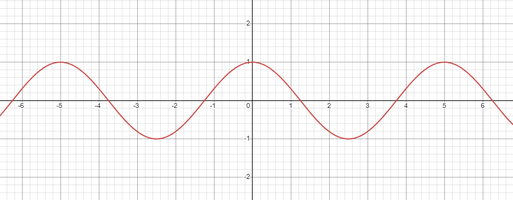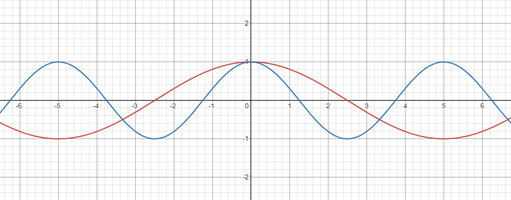Consider a random process [imath]X(t)[/imath] defined by
[imath]X(t) = \cos(2\pi f_c t)[/imath]
in which the frequency [imath]f_c[/imath] is a random variable uniformly distributed over the interval [imath][0, W][/imath]. Show that [imath]X(t)[/imath] is stationary.
My attempt.
Let [imath]W = 1[/imath].
First, I chose the frequency [imath]f_{c_1} = \frac{W}{5} = \frac{1}{5}[/imath] to have a period of [imath]T = 5[/imath] which is easy to visualize.
[imath]X_1(t) = \cos(2\pi t/5)[/imath]
I will provide the graph of the random process [imath]X_1(t)[/imath].

Now, the definition says:
The random process [imath]X(t)[/imath] is said to be stationary in the strict sense or strictly stationary if the following condition holds,
[imath]F_{X(t_1+\tau), . . . .,X(t_k+\tau)}(x_1, . . . .,x_k) = F_{X(t_1), . . . .,X(t_k)}(x_1, . . . .,x_k)[/imath]
for all time shifts [imath]\tau[/imath], all [imath]k[/imath], and all possible choices of observation times [imath]t_1,....,t_k[/imath]
where [imath]F[/imath] is the probability density function.
Now, I will create another process with frequency [imath]f_{c_2} = \frac{W}{10} = \frac{1}{10}.[/imath]
My two processes are:
[imath]X_1(t) = \cos(2\pi t/5)[/imath]
[imath]X_2(t) = \cos(2\pi t/10)[/imath]
I will provide a graph for the two processes together.

From my understanding, if I can show [imath]F_{X(t_1)}(x_1) = F_{X(t_2)}(x_2)[/imath], I can conclude the process is stationary.
Choosing [imath]t_1 = 1.25 \ \text{s} \ \text{and} \ t_2 = -1.25 \ \text{s}[/imath] will guarantee the values of two processes are positive.
[imath]0 \leq x_1 \leq X_1(t)[/imath]
[imath]0 \leq x_2 \leq X_2(t)[/imath]
It is clear now that the probability density function [imath]F_{X(1.25)}(x_1)[/imath] is nonzero for positive argument with respect to zero.
And [imath]F_{X(-1.25)}(x_2)[/imath] is nonzero for positive argument with respect to zero as well.
My Question is.
Can I conclude from this that [imath]F_{X(1.25)}(x_1) = F_{X(-1.25)}(x_2)[/imath]? And the random process [imath]X(t)[/imath] is stationary. If yes, how can this be possible when the two processes have different areas under their graphs?
[imath]X(t) = \cos(2\pi f_c t)[/imath]
in which the frequency [imath]f_c[/imath] is a random variable uniformly distributed over the interval [imath][0, W][/imath]. Show that [imath]X(t)[/imath] is stationary.
My attempt.
Let [imath]W = 1[/imath].
First, I chose the frequency [imath]f_{c_1} = \frac{W}{5} = \frac{1}{5}[/imath] to have a period of [imath]T = 5[/imath] which is easy to visualize.
[imath]X_1(t) = \cos(2\pi t/5)[/imath]
I will provide the graph of the random process [imath]X_1(t)[/imath].

Now, the definition says:
The random process [imath]X(t)[/imath] is said to be stationary in the strict sense or strictly stationary if the following condition holds,
[imath]F_{X(t_1+\tau), . . . .,X(t_k+\tau)}(x_1, . . . .,x_k) = F_{X(t_1), . . . .,X(t_k)}(x_1, . . . .,x_k)[/imath]
for all time shifts [imath]\tau[/imath], all [imath]k[/imath], and all possible choices of observation times [imath]t_1,....,t_k[/imath]
where [imath]F[/imath] is the probability density function.
Now, I will create another process with frequency [imath]f_{c_2} = \frac{W}{10} = \frac{1}{10}.[/imath]
My two processes are:
[imath]X_1(t) = \cos(2\pi t/5)[/imath]
[imath]X_2(t) = \cos(2\pi t/10)[/imath]
I will provide a graph for the two processes together.

From my understanding, if I can show [imath]F_{X(t_1)}(x_1) = F_{X(t_2)}(x_2)[/imath], I can conclude the process is stationary.
Choosing [imath]t_1 = 1.25 \ \text{s} \ \text{and} \ t_2 = -1.25 \ \text{s}[/imath] will guarantee the values of two processes are positive.
[imath]0 \leq x_1 \leq X_1(t)[/imath]
[imath]0 \leq x_2 \leq X_2(t)[/imath]
It is clear now that the probability density function [imath]F_{X(1.25)}(x_1)[/imath] is nonzero for positive argument with respect to zero.
And [imath]F_{X(-1.25)}(x_2)[/imath] is nonzero for positive argument with respect to zero as well.
My Question is.
Can I conclude from this that [imath]F_{X(1.25)}(x_1) = F_{X(-1.25)}(x_2)[/imath]? And the random process [imath]X(t)[/imath] is stationary. If yes, how can this be possible when the two processes have different areas under their graphs?
Last edited:
